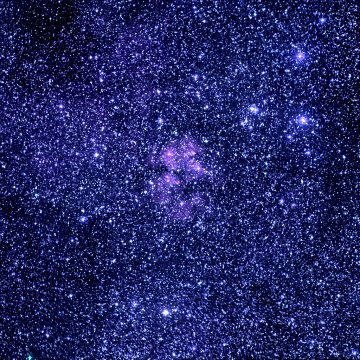Sh 2-124
Also called
KR 7Coordinates: (94.48°, -1.55°)
[ Catalog | Explorer | SIMBAD ]
Infrared imaging from MSX reveals a bubble in this direction.
Felli and Harten give a list of 5 ionising stars, including the O7.5 class LS III +50 28, and support the BFS distance estimate of 2600 parsecs. However, other sources argue that this star may be too cool to be the ionising star.
Chini and Wink identify two uncatalogued ionising stars, with classes O7V and B2V, and give a distance estimate of 3600 parsecs.
Crampton, Georgelin and Georgelin give a kinematic distance (based on gas velocity) of 4400 parsecs.
However, a 2011 paper states that LS III +50 28 may be too cool to be the ionising star for this nebula. [2]
Gives a kinematic distance estimate of 4400 parsecs.[3]
Identifies two ionising stars. Star 1 is O7V, star 2 is B2V. Distance estimate of 3600 parsecs.[4]
This paper includes a radio image of Sh 2-124 as it is in the same field as the supernova remnant CTB 104A, which the paper is actually about. There is no further information about the nebula, however.[5]
Notes
1. ^ Felli, M. & Harten, R. H. (1981). "A high-resolution search for small-scale structure in Sharpless H II regions at 4.995 GHz. II - General properties of the entire sample. III - Description of selected sources", Astronomy and Astrophysics, Vol. 100, 28-58. [1981A&A...100...28F]
2. ^ Arvidsson, K. & Kerton, C. R. (2011). "Submillimeter and Molecular Views of Three Galactic Ring-like H II Regions", The Astronomical Journal, Vol. 141, 153. [2011AJ....141..153A]
3. ^ Crampton, D., Georgelin, Y. M., & Georgelin, Y. P. (1978). "First optical detection of W51 and observations of new H II regions and exciting stars", Astronomy and Astrophysics, Vol. 66, 1-11. [1978A&A....66....1C]
4. ^ Chini, R. & Wink, J. E. (1984). "The galactic rotation outside the solar circle", Astronomy and Astrophysics, Vol. 139, L5-L8. [1984A&A...139L...5C]
5. ^ Uyaniker, Bülent, Kothes, Roland, & Brunt, Christopher M. (2002). "The Supernova Remnant CTB 104A: Magnetic Field Structure and Interaction with the Environment", The Astrophysical Journal, Vol. 565, 1022-1034. [2002ApJ...565.1022U]
Distance estimates
2600 pc [1982ApJS...49..183B]4400 pc [1978A&A....66....1C]
3600 pc [1984A&A...139L...5C]
Links
[ DSS | ADS | ADS Abstract ]
map | book | blog | gallery | sources

This image was created using the POSS-II/UKSTU data of the Digitized Sky Survey and SuperCOSMOS using the process described here.
According to my correspondence with the Royal Observatory Edinburgh and the Space Telescope Science Institute, I am allowed to use the POSS-II/UKSTU data to create and display images for non-commercial purposes so long as I include this fine print for the SuperCOSMOS data:
Use of these images is courtesy of the UK Schmidt Telescope (copyright in which is owned by the Particle Physics and Astronomy Research Council of the UK and the Anglo-Australian Telescope Board) and the Southern Sky Survey as created by the SuperCOSMOS measuring machine and are reproduced here with permission from the Royal Observatory Edinburgh.
and this acknowledgement taken from the DSS site:
The Digitized Sky Surveys were produced at the Space Telescope Science Institute under U.S. Government grant NAG W-2166. The images of these surveys are based on photographic data obtained using the Oschin Schmidt Telescope on Palomar Mountain and the UK Schmidt Telescope. The plates were processed into the present compressed digital form with the permission of these institutions.
The Second Palomar Observatory Sky Survey (POSS-II) was made by the California Institute of Technology with funds from the National Science Foundation, the National Geographic Society, the Sloan Foundation, the Samuel Oschin Foundation, and the Eastman Kodak Corporation.
The UK Schmidt Telescope was operated by the Royal Observatory Edinburgh, with funding from the UK Science and Engineering Research Council (later the UK Particle Physics and Astronomy Research Council), until 1988 June, and thereafter by the Anglo-Australian Observatory. The blue plates of the southern Sky Atlas and its Equatorial Extension (together known as the SERC-J), as well as the Equatorial Red (ER), and the Second Epoch [red] Survey (SES) were all taken with the UK Schmidt.
The "Second Epoch Survey" of the southern sky was made by the Anglo-Australian Observatory (AAO) with the UK Schmidt Telescope. Plates from this survey have been digitized and compressed by the ST ScI. The digitized images are copyright ? 1993-5 by the Anglo-Australian Observatory Board, and are distributed herein by agreement.
The "Equatorial Red Atlas" of the southern sky was made with the UK Schmidt Telescope. Plates from this survey have been digitized and compressed by the ST ScI. The digitized images are copyright ? 1992-5, jointly by the UK SERC/PPARC (Particle Physics and Astronomy Research Council, formerly Science and Engineering Research Council) and the Anglo-Australian Telescope Board, and are distributed herein by agreement.
The compressed files of the "Palomar Observatory - Space Telescope Science Institute Digital Sky Survey" of the northern sky, based on scans of the Second Palomar Sky Survey are copyright ? 1993-1995 by the California Institute of Technology and are distributed herein by agreement. The compressed files of the "Palomar Observatory - Space Telescope Science Institute Digital Sky Survey" of the northern sky, based on scans of the Second Palomar Sky Survey are copyright ? 1993-1995 by the California Institute of Technology and are distributed herein by agreement.